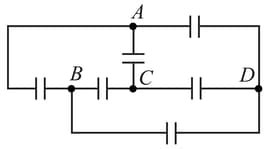A very small earthed conducting sphere is at a distance from a point charge and at a distance from a point charge . At a certain instant, the sphere starts expanding so that its radius grows according to the law . Determine the time dependence of the current in the earthing conductor, assuming that the point charges and the centre of the sphere are at rest, and in due time the initial point charges get into the expanding sphere without touching it (through small holes).

Important Questions on Electricity and Magnetism
Three uncharged capacitors of capacitance , and are connected as shown in Fig. to one another and to points , and at potentials , and . Determine the potential at point .

The thickness of a flat sheet of a metal foil is , and its area is . A charge is located at a distance from the centre of the sheet such that
Determine the force with which the sheet is attracted to the charge , assuming that the straight line connecting the charge to the centre of the sheet is perpendicular to the surface of the sheet.
Where must a current source be connected to the circuit shown in the figure, in order to charge all the six capacitors having equal capacitances?

A parallel-plate capacitor is filled by a dielectric whose permittivity varies with the applied voltage according to the law , where . The same (but containing no dielectric) capacitor charged to a voltage is connected in parallel to the first "nonlinear" uncharged capacitor. Determine the final voltage across the capacitors.
Two small balls of mass , bearing a charge each, are connected by a nonconducting thread of length . At a certain instant, the middle of the thread starts moving at a constant velocity perpendicular to the direction of the thread at the initial instant. Determine the minimum distance between the balls,
Two balls of charge and initially have a velocity of the same magnitude and direction. After a uniform electric field has been applied during a certain time, the direction of the velocity of the first ball changes by , and the velocity magnitude is reduced by half. The direction of the velocity of the second ball changes thereby by .
In what proportion will the velocity of the second ball change? Determine the magnitude of the charge-to-mass ratio for the second ball if it is equal to for the first ball. The electrostatic interaction between the balls should be neglected.
Why do electrons and not ions cause collision ionization of atoms, although both charges acquire the same kinetic energy ( is the charge of the particles, and is the potential difference) in an accelerating field? Assume that an atom to be ionized and a particle impinging on it have approximately the same velocity after the collision.
